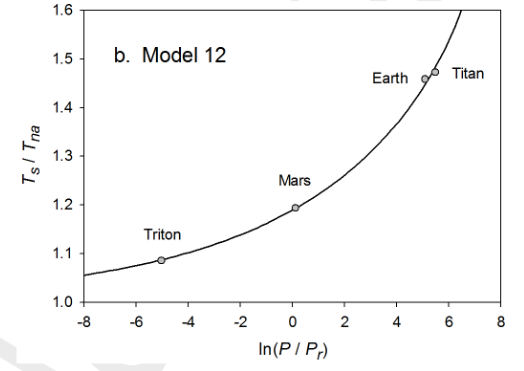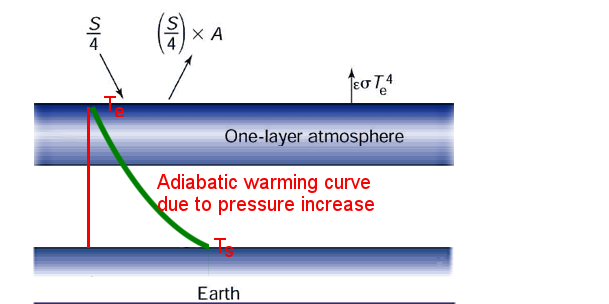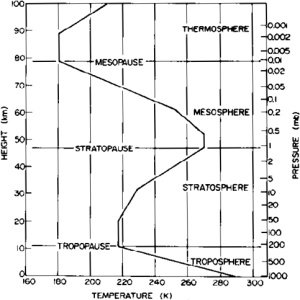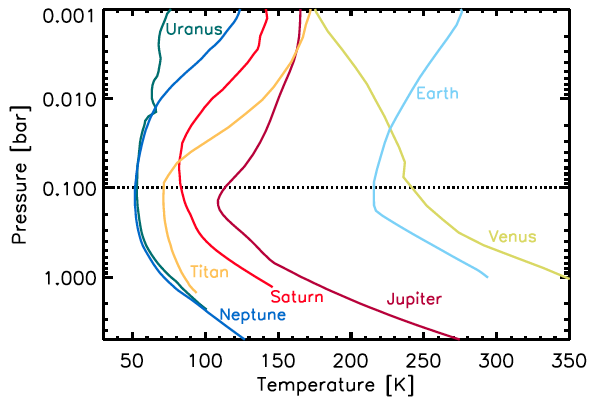I’ve come across evidence that could be interpreted as showing that there is some kind of mechanism in the atmosphere that compensates for changes in greenhouse gas composition so that changes in CO2 levels would be insignificant. This is in no sense finished work, but is instead a very brief outline to make others aware of this potential.In a paper by Ned Nikolov & Karl Zeller (“New Insights on the Physical Nature of the Atmospheric Greenhouse Effect Deduced from an Empirical Planetary Temperature Model“) they show a close relationship between planetary pressure (and a few other things) and greenhouse temperature as shown below:

This appears to show a very close relationship, and this is not surprising because greenhouse temperature is effectively the temperature from the “average emission height” x the lapse rate. And the average emission height is itself largely dependant on where the “top of the atmosphere is” (a very crude model of this is shown below but for a more detailed explanation see The Greenhouse effect)

Removing all the irrelevant components from the Penn State “opaque atmosphere” model, we are left with the above.
This means, there is no surprise that the greenhouse temperature for other planets is related to pressure. What however is surprising is Nikolov & Zeller’s contention that there is no apparent effect from greenhouse gas concentration.
For obvious reasons I’ve questioned this, not least because the scale of the Greenhouse effect is so small relative to pressure effects that it could easily get lost. To explain, it’s well known the greenhouse temperature is the log of greenhouse concentration. But when you then plot this log on a log graph, you have a log of a log which is then a very small quantity. To put it in perspective I very quickly estimated the change from 1pp to 1,000,000ppm (i.e. 100%) CO2 and drew this as below:
 So, even if the earth’s atmosphere were 100% CO2, by a slight redrawing of the line, the earth could be said to be “fitting” to the curve. Thus, I felt it was safe to argue that they were not seeing any affect of greenhouse gas composition, because it was “lost in the noise”. This still meant that changing greenhouse gas composition would effectively lower or raise the average height of emissions and change temperature, but compared to the overall greenhouse effect (determined by pressure) this change would be small.
So, even if the earth’s atmosphere were 100% CO2, by a slight redrawing of the line, the earth could be said to be “fitting” to the curve. Thus, I felt it was safe to argue that they were not seeing any affect of greenhouse gas composition, because it was “lost in the noise”. This still meant that changing greenhouse gas composition would effectively lower or raise the average height of emissions and change temperature, but compared to the overall greenhouse effect (determined by pressure) this change would be small.This argument however was based on my assumption that the temperature profile through the atmosphere was constant. And that a change in height would mean moving up or down the temperature profile to change the average temperature of emitted IR, and therefore average heat lost. (Lower temperatures mean IR comes from cooler atoms so less heat is emitted).

However… I then came across this paper:
“Common 0.1 bar tropopause in thick atmospheres set by pressure-dependent infrared transparency” (Robinson & Catling 2014 ). And this graph say it all:
 This shows that the temperature profile of atmospheres as diverse as Earth and Jupiter seem to be determined in the lowest parts by the lapse rate (which fit with Nikolov & Zeller) and then there is an effective “top of the atmosphere” at 0.1bar – a top which seems to be present in almost all atmospheres including some with very different greenhouse gas compositions.
This shows that the temperature profile of atmospheres as diverse as Earth and Jupiter seem to be determined in the lowest parts by the lapse rate (which fit with Nikolov & Zeller) and then there is an effective “top of the atmosphere” at 0.1bar – a top which seems to be present in almost all atmospheres including some with very different greenhouse gas compositions.This appears to show that rather than greenhouse gases acting on a static temperature profile as I was using as a model, that the temperature profile may adapt so that the behaviour is largely independent of the exact composition (As Nikolov & Zeller) have argued. If this is right it’s a very important observation and could completely change our understanding of how greenhouse gases may affect the earth’s atmosphere.
In layman’s terms this could “blow a hole in the greenhouse gas theory” – at least in terms of how atmosphere respond to changes in gas composition. Because if the temperature profile changes so that we have in effect (largely) the same atmosphere irrespective of the exact composition, then changes in CO2 may have almost no impact on the climate (except to grow big fruit etc.).
The big caveat here is that again the above graph is a log with respect to pressure (i.e. height); and the atmospheres are far from being an exact fit with each other and so you could hide an awful lot of greenhouse gas change in there. However, this 0.1bar is close or at the boundary between the over-turning troposphere and the static stratosphere. And it is not impossible that the dynamics of the lower atmosphere in some way compensate and tend to reduce the impact of any change in the actual greenhouse gas composition. In othe words, the overturning may in some way actively compensate for changes in greenhouse composition so that we end up with largely the same greenhouse temperature.
Summary
“Greenhouse gases are important in planetary atmospherics because of their affect on planetary atmospheric temperature by the emission of infrared. As such any increase in greenhouse gas temperature within a fixed temperature profile would tend to cause warming within regions of the atmosphere where temperatures lower with height because the average radiative temperature would reduce. However … according to work by Robinson and Catling (2014) the temperature profile of planetary atmospheres is dependant on pressure such that there is an effective “top of the atmosphere” at around 0.1bar, corresponding to the effective top of bulk infra-red heat emissions, which on earth corresponds to the top of our troposphere or convective region. Likewise the lower atmosphere on other planet(oids?) show similar convective regions(I think that is right?).
This indicates that rather than greenhouse gas composition acting in isolation, the planetary atmosphere appears to adjust such that the dominant factor affecting surface temperature is not the gas composition, but instead the height of this 0.1bar “top of atmosphere”. The greenhouse gas temperature is then largely determined by the height of the 0.1bar pressure and the lapse rate (which is determined by gravity & specific heat capacity of gases).


Interesting, but I would say one thing though; be careful of Volokin & Zeller (see https://wattsupwiththat.com/2016/09/14/climate-skeptics-behaving-badly/comment-page-1/). It’s interesting that the start of the introduction to their referenced article mentions the Nikolov & ReLlez paper that’s discussed here – http://retractionwatch.com/2016/09/13/u-s-govt-researchers-withdraw-climate-paper-after-using-pseudonyms/. I’m not saying there’s anything wrong in those papers, but their behaviour isn’t doing the sceptical community many favours!
HTH
John
(Oh – and sorry for a bit of pedantry, but the ‘affect’ in the first line of your summary should be ‘effect’)
I think it’s sound advice to be sceptical – particularly in light of some of the discussion I’ve had (behind the scenes) with the authors. However, that does not detract from the fact they have done some important work even if I’m not over enthusiastic with the way they analyse the data.
NOT FOR PUBLICATION IN THIS FORM PLEASE<<<<<<<<<<<<<
You may be interested in the experimental proof that two or more radiative fluxes CANNOT and MUST NOT be added together.
But of course that is exactly what the Greenhouse Effect is supposed to be: Earth's temperature = Heat from the Sun + Heat from the Greenhouse Gases. Heat (radiative flux) can no more be added together than say temperature, or pressure, or altitude or a number of other measures. The idea that you can aggregate heat flux in this way also leads to completely impossible outcomes such as infinite temperatures and energy for nothing.
The universities have been teaching this nonsense for years – maybe decades; but why nobody has picked them up on it is a mystery to me.
It may be because flux is proportional to T^4 and that puts off people asking questions; worked with me – didn't spot if for ages.
Let me know if you'd like me to send it – it's about 3/4 pages long including the theory (not mine – the stuff they teach), results and comparison with what two fluxes hitting the same target really should be.
John, the one thing I’m constantly learning is that much of what we get taught as undeniable truth in science is anything but.
Scottish-Sceptic,
Don’t for one moment believe John Murphy’s argument above. His error might be called the ‘great Slayer fallacy’. It has caused global warming scepticism a lot of unnecessary adverse publicity.
It is true that the UV energy from the Sun travels in the same direction as the LW downward component of the radiation asserted by atmospheric CO2 but the two must not be (and are not, by people who understand radiation physics) ever added together.
This is simply because their spectrums do not (significantly) overlap. They are in effect like trains travelling in the same direction on two separate tracks.
The fraction of the SW downward energy from the Sun that is absorbed by the earth results (assuming steady state surface temperature conditions) in an upward assertion of LW infrared energy equal to that absorbed from the Sun. A very small fraction of that upward LW assertion is offset by the LW downward assertion of energy from the CO2 (only where the wavebands overlap).
To overcome the energy disbalance that would otherwise occur between the energy absorbed by the earth’s surface and the energy flowing back to space, the temperature of the surface (at steady state) is higher than it would be if there were no atmospheric CO2.
The important point here is that the “top of atmosphere” appears to occur at a set pressure. From there it’s just simple physics to explain the greenhouse effect in terms of pressure and whilst radiation is involved, it is not necessary to invoke it in the explanation.
However, you can lead a sceptic to water … but they’ll still ask for whisky.
Addendum
To put it bluntly I’m pretty pissed off with climate. I now understand enough to explain not only the apparently random changes but also the more directional change we saw in the 1970s. And as a result I can’t see this issue causing major hassles. But whilst I understand the climate, I don’t understand how to make other people understand it. Nor to be completely honest do I think many people want to understand it – or at least they don’t want to know what really drives the climate – instead on both sides people are wanting the climate to work differently to the way it actually works.